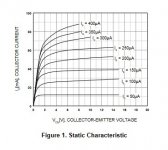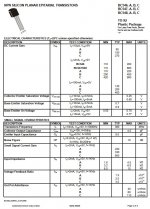I'd rather call that a buffered RC-filter...
Isn't that what a "capacitance multiplier" is?
Anyway, I don't see an advantage. The main source of ripple on the output with a well-designed input stage is the ripple that makes it into the power stage from the supply. Having an active device in line with the power means you're going to modulate the power rails. Ripple rejection on the supply is good, but I'd rather reject ripple in the input itself.
But hey, I may be wrong. I just know what my amplifiers do in practice.
Never heard or seen a buffered RC-filter as such. In how much is such a configuration able to 'absorb' ripple from its output side, or able to 'flatten' the incoming ripple? The RC attenuates the last with a factor of 5/475 (-55dB) and this is with the emitterfollower put on the output.Isn't that what a "capacitance multiplier" is?
And as the capacitor is charged up to the supply voltage, there's not much left for the transistor, driven to a very low Vce (almost same as Vbe) into its ohmic area. It's a poor mans power supply regulator and I sincerely hope that one not expects the capacitive value at the base is 'multiplied' to the emitter with the factor beta. An emitter follower is an impedance transformer and not a capacitance transformer. The 'h-parameters' prevail here.
Attachments
Having had to repair a few overly complicated amps in my life I don't envy trying to repair this monster. The lack of output protection assures sometime in it's life it will need repair. Something that happened to me in the 70's time and time again. All the Southwest technical products amps I had to repair made we want to kill the designer...
If you don't own a curve tracer, get one. Not a homemade component tester. Something that can stress parts at 100+ volts and look for "marginal" components. A component tester is useful for identifying shorted components in circuit.
I don't miss repairing amps, TVs and CB radios back in the 70's with only a $10 Radio Shack multi-meter....
If you don't own a curve tracer, get one. Not a homemade component tester. Something that can stress parts at 100+ volts and look for "marginal" components. A component tester is useful for identifying shorted components in circuit.
I don't miss repairing amps, TVs and CB radios back in the 70's with only a $10 Radio Shack multi-meter....
I count 45 transistors in total (ex U1).
I can make a decent sounding 50 watt amp with 7 transistors.
Is this not a case of chasing diminishing returns ?
Having had to repair a few overly complicated amps in my life I don't envy trying to repair this monster. The lack of output protection assures sometime in it's life it will need repair.
You know plenty and have lots of experience, but that said, not one of my amplifiers has been destroyed by a short, except while I was prototyping and didn't have experience with routing wires properly (in the early days). So in >15 years, I have no amplifier short failures, and a number of people are using and have been using my amplifiers for longer than 10 years.
My plan to avoid repairs from shorts (because that's a whole new nightmare) is to make the amplifiers modular, so only the single channel can be replaced. These are usually cheap (relative to the amplifier). And then I use Speakon connectors. The user must connect the wires to the speakers before the amplifier.
I can make a briliant sounding 8W class A Hiraga with 6 transistors.I can make a decent sounding 50 watt amp with 7 transistors.
Is this not a case of chasing diminishing returns ?
Let's keep close to the topic; curious about BF245C's reply.
You know plenty and have lots of experience, but that said, not one of my amplifiers has been destroyed by a short, except while I was prototyping and didn't have experience with routing wires properly (in the early days). So in >15 years, I have no amplifier short failures, and a number of people are using and have been using my amplifiers for longer than 10 years.
This is a stereo I built in 1977. Preamp was based on a Douglas Self design. Power amp is a clone I made of the Quad 405. The 405 clone worked the 1st time I turned it on. It failed when I took it to college and didn't notice a speaker wire had shorted. It's been working ever since without a single repair. I built numerous amps prior to this, tube and semi including SWTP kits. The SWTP amps sucked and needed constant repair. The one at my frat house also blew regularly.
Having an overly complicated design can be a nightmare especially if they are not thermally stable like the designs from SWTP. The SWTP amps worked great...as long as you didn't push them for any extended time...Kaboom every time. My Quad 405 clone was used for many an all night party without issue.
My turntable was built from a kit. All metal work done with a Dremel and metal files. PCBs made using tape and etched in a sink.
Attachments
Last edited:
Never heard or seen a buffered RC-filter as such.
When entered in our trusty companion Google Images' search field, "Capacitive multiplier" returns thousands of photos of the same part of the circuit I used, while "buffered RC filter" returns non-consistent results of buffered op-amps, active filters etc.
But I agree with you that "buffered RC filter" is a more accurate name, I just used the name everyone's familiar with.
I sincerely hope that one not expects the capacitive value at the base is 'multiplied' to the emitter with the factor beta.
Don't worry, I know it can't perform such miracles.
I don't envy trying to repair this monster.
Don't be so mean, the circuit is big, I'll give you that, but have you seen how small is the space it occupies on the perfboard? 😀
The lack of output protection assures sometime in it's life it will need repair
This is not a standalone circuit, I have a folder dedicated to protection circuit schematics (delayed turn-on/off, DC offset detector, Overtemp Shutdown etc), I deliberately didn't include output protection because it introduces nonlinearity.
I can make a decent sounding 50 watt amp with 7 transistors.
That implies you're using VAS bootstrapping instead of a CCS, right? I'm not really a fan of that.
Is this not a case of chasing diminishing returns ?
It certainly would be if my only goal was to build an amp. However the main motivation here was to make the fully symmetrical topology work while still using active loads for the IPS.
You can use SMD components to get minature circuit. By this the diy will concider it as module. You don't complain if a driver IC is complicated, on the contrary the more sophisticated is the module the higher esteem it recieves. For protections , you can design an add on seperate module.
That implies you're using VAS bootstrapping instead of a CCS, right? I'm not really a fan of that.
Glad I'm not the only one! 😀
- Home
- Amplifiers
- Solid State
- Push-Pull VAS [50W@8R]


